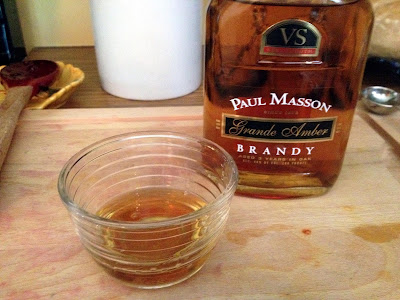 |
| Enough basil for several batches |
You can freeze it in jars, muffin cups, or ice cube trays. It's great to take some out in the dead of winter to enjoy over pasta or drizzled on top of soups. It's a little taste of summer all year round.
 |
| Basil pesto on left and roasted tomato pesto on right (ready to go in freezer) |
I've also been making quite a bit of roasted tomato pesto since roasting my own tomatoes recently. This batch was made with cherry tomatoes that were roasted in a 250 degree oven for a couple of hours.
 |
| If making both pestos at the same time, make the basil pesto first. That way, there is no need to wash the food processor. |
You see, we're a little different from most folks in that we don't really like raw tomatoes that much. I can eat them on a sandwich or on a salad, but I can never go through a lot of cherry tomatoes on my own. So, I've been roasting the leftovers and using them, along with basil from the garden, to make roasted tomato pesto. It is delicious tossed with warm pasta or spread on a sandwich, and it is so easy to make. As we speak, I am about to pop a couple more trays of cherry tomatoes into the oven to roast. Just halve them, drizzle with olive oil, season with salt, and roast for 2-3 hours until dry and slightly chewy. Then use them in pasta, salads, or this pesto.
 |
| Basil pesto cubes ready for freezer |
The basil pesto recipe I use can be found at the link at the top of this page or on my Preserving page under Freezing. The Roasted Tomato Pesto recipe follows. Enjoy!
 |
| Roasted Tomato Pesto cubes ready for freezer |
Roasted Tomato Pesto- makes approximately 1 1/2 cups or 1 ice cube tray
If you do not wish to use tomatoes you have roasted, you can use sun dried tomatoes from the market. If you use store-bought tomatoes, drain the oil and use it for a portion of the olive oil if desired. When adding the oil, use your judgement. Quantities of oil can vary from batch to batch depending on the amount of moisture still in your tomatoes. You want a spreadable pesto but nothing too oily.
1 cup basil, lightly packed
1 cup roasted tomatoes, can be Romas or cherry tomatoes
1/4 cup almonds (you can use whatever nut is available or pine nuts)
1/2 tsp kosher salt
2 Tbsp Parmesan cheese
4 cloves garlic, peeled
1/3-1/2 cup good quality olive oil
Juice of 1/2 lemon (add if you feel it needs additional acidity...I usually do)
Add your basil, roasted tomatoes, almonds, salt, garlic, and cheese to the processor. Pulse several times until ingredients are combined. Slowly drizzle the oil into the food processor via the tube as the processor is running. Add only as much oil as you need to reach the proper consistency. Taste the pesto and adjust seasoning. Add lemon juice if desired for additional acidity. Pulse pesto one last time to combine before scooping the mixture into ice cube trays, muffin cups, or jars to freeze. Once frozen, the pesto in the ice cube trays and muffin cups can be removed and placed in a freezer bag for storage. If you want to keep this pesto in the refrigerator for a few days rather than freezing, place the mixture in a jar and pour a little olive oil on top to prevent it from darkening.
Printable Version






















